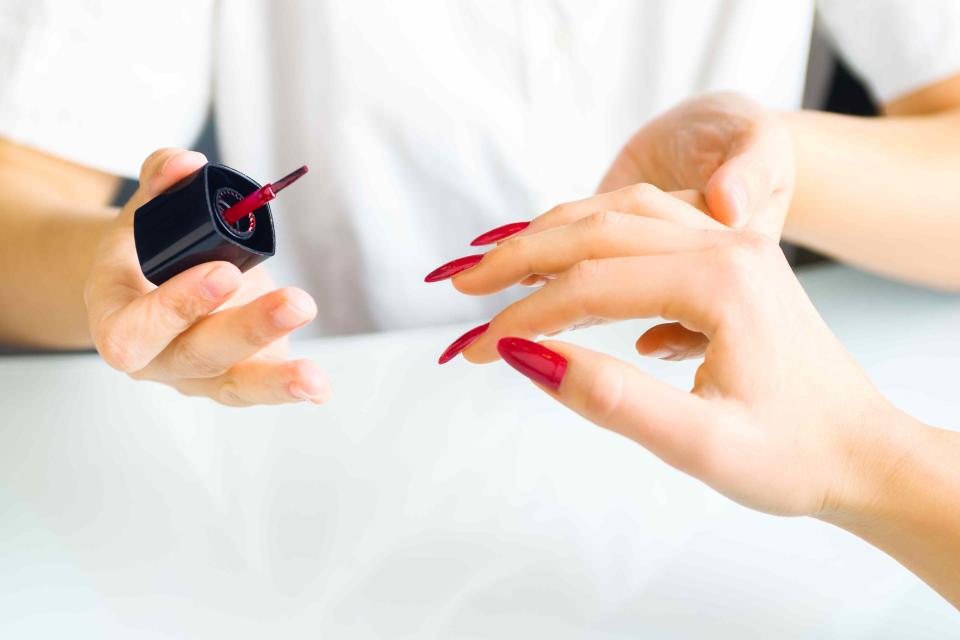Polygel Is the Hybrid Between Gel and Acrylic Nails Taking Over Salons
Experts share why they’re loving the new formula.

Carol_Anne/Getty Images
Anyone who frequents nail salons is probably familiar with gel, powder, and acrylic—all of which have pros and cons that might have you sacrificing nail health over durability. Enter polygel, a new hybrid formula getting buzz in nail salons for being less bulky than acrylic and less damaging than gel, yet just as long-lasting as both.
We tapped some of the top nail artists for all the insight on polygel nails, from what it is and the application to the price point and removal process.
What Are Polygel Nails?
“Polygel is considered to be a hybrid formula that combines the durability of acrylic and the elasticity type application of a builder gel,” says Syreeta Aaron, a LECHAT Nails brand educator. The formula comes out in a tube that looks like toothpaste, which is then applied directly onto the nail, molded to the length and shape you desire, and cured under a gel lamp.
According to experts, Gelish PolyGel is approximately 23 percent lighter than acrylics and 16 percent lighter than traditional hard gels, but it's just as strong. While every salon and artist will have different pricing, a standard full set of polygel nails will cost anywhere from $50 to $60, but Aaron notes that the price can increase based on nail shape and length.
How to Apply Polygel Nails
There are two methods that Aaron says are typically used to apply polygel nails. There isn’t one that’s better than the other—it’s just a personal preference for the nail technician.
One method involves squeezing the gel into a full tip that’s flexible, spreading the product thinly into the tip, pressing on the natural nail, and curing it under a gel lamp. The other method involves applying the product onto the nail and brushing the gel down to the preferred shape and length on top of a form.
Michelle Saunders, nail technician and founder of Saunders & James Nail Care, adds that unlike acrylics, polygel is best applied with a medium-sized sculpting brush and needs to be cured in the gel lamp.
Is Polygel Better Than Acrylic?
Although we can’t say if polygel is “better” than acrylic nails, they are very different. One benefit of polygel is that it’s not harmful to inhale unlike acrylics. “Polygel can be considered safer for the technician and for the client because neither is inhaling chemicals such as monomer that traditionally occurs with acrylics,” says Aaron.
Another pro is that you can shape and maneuver the nail shape for a longer period of time. “ Since polygel only hardens after you place it underneath the gel lamp, it allows you to manipulate the nail for as long as you like, versus acrylic which dries and hardens soon after applying,” says Aaron.
Aside from that, the other benefits to acrylic and polygel are typically the same—both can last up to three weeks and be refilled when necessary.
How to Remove Polygel Nails
The steps to remove polygel nails are similar to gel nails—as with any nail removal, soaking off is always the best course of action as opposed to pulling or tearing off the application, which can peel off layers of the nail plate.
“To remove the polygel you will need to first remove the shiny coat/top coat. Once that layer has been broken, you can then soak in acetone and continue to file until the application is completely gone,” says Aaron.
Additionally, Aaron mentions that soaking in soap and oil mixed with warm water has been shown to remove poly gel. “This only works if the set that you have on is very old and has plenty of lifting to it,” she notes. “This allows the oil to penetrate between the nail plate and the application, causing the application to pop off easily.”
Should You Do Polygel Nails at Home?
While you technically can apply polygel nails at home, it’s not recommended by our nail artists. “Most professional nail products can be purchased online to try doing polygel at home, but I always recommend seeing a professional for application and removal to avoid damage.” says Aaron. “A nail technician trained in polygel will help prevent unwanted damage to the nail bed that may result from a lack of proper instruction or guidance.”
If you decide to apply polygel nails at home, Aaron recommends doing thorough research and looking at reviews and tutorials of the brand you’re choosing to make sure it’s the right fit for you.
For more Real Simple news, make sure to sign up for our newsletter!
Read the original article on Real Simple.

